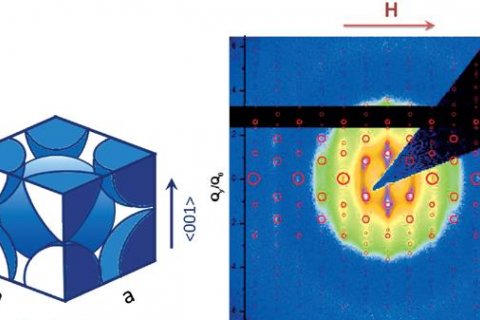Colloidal crystals with novel symmetry are induced by magnetic interactions

Spontaneous formation of colloidal crystals with body-centred tetragonal structure is demonstrated in our experiment at the Dutch-Belgian beamline DUBBLE at the European synchrotron in Grenoble, France.
Manipulation of the self-assembly of colloids has recently attracted significant attention. Introduction of anisotropic interaction between the particles by changing the shape of the particles, adding “patches” at their surface or introducing anisotropic dipole-dipole interactions allow to achieve periodic structures with lower symmetry. The use of the magnetic particles in combination with an external magnetic field is one of the easiest ways to influence the resulting crystal structure. In our recent publication [1] we have studied the different crystal structures exhibited by self-assembly of core–shell magnetite/silica nanoparticles using microradian x-ray scattering technique. We find that the equilibrium structure in absence of the field is random hexagonal close-packed (RHCP) one. External field drives the self-assembly toward a body-centred tetragonal (BCT) structure. Our findings are in good agreement with simulation results on the assembly of these particles. The results paves a way toward developing novel stimuli-responsive structures for photonic applications, sensors and drug delivery. Results of this research is published in a prestigious journal Angewandte Chemie (2013 impact factor = 11.336).
[1] Antara Pal, Vikash Malik, Le He, Ben H. Erné, Yadong Yin, Willem K. Kegel, Andrei V. Petukhov, Tuning the Colloidal Crystal Structure of Magnetic Particles by External Field, Angew. Chem. Int. Ed., 54, 1803-1807 (2015); DOI: 10.1002/anie.201409878.

